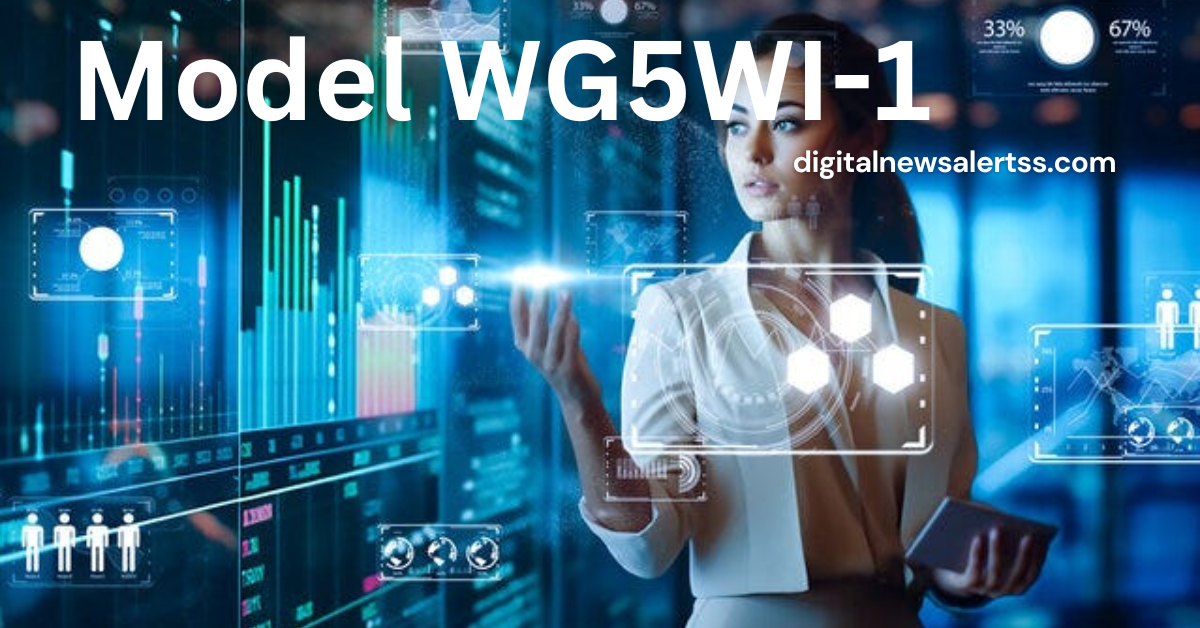In the ever-evolving landscape of artificial intelligence, one innovation stands out for its remarkable versatility and groundbreaking capabilities: Model WG5WI-1. This cutting-edge algorithmic framework is transforming how we approach complex problems across multiple industries. In this comprehensive guide, we’ll explore the ins and outs of Model WG5WI-1, its applications, and its potential to revolutionize the way we interact with technology.
What is Model WG5WI-1?
Model WG5WI-1 is a state-of-the-art artificial intelligence framework designed to tackle intricate challenges in various fields. Unlike traditional AI models that excel in specific domains, WG5WI-1 boasts a unique ability to adapt and perform across a wide range of applications. This versatility has caught the attention of researchers, businesses, and tech enthusiasts alike.
Key Features of Model WG5WI-1:
1. Adaptive Learning: The model continuously improves its performance through real-time data analysis.
2. Multi-domain Expertise: WG5WI-1 can seamlessly switch between different fields of knowledge.
3. Natural Language Processing: It excels in understanding and generating human-like text.
4. Computer Vision: The model can interpret and analyze visual data with high accuracy.
5. Predictive Analytics: WG5WI-1 offers powerful forecasting capabilities for various industries.
How Model WG5WI-1 Works
At its core, Model WG5WI-1 utilizes a sophisticated neural network architecture that allows it to process vast amounts of data efficiently. The model employs advanced machine learning techniques, including:
1. Deep Learning: WG5WI-1 uses multiple layers of artificial neurons to identify patterns and make decisions.
2. Transfer Learning: The model can apply knowledge gained from one task to improve performance on related tasks.
3. Reinforcement Learning: WG5WI-1 learns through trial and error, optimizing its actions based on rewards and penalties.
4. Federated Learning: This approach allows the model to learn from decentralized data sources while maintaining privacy.
Applications of Model WG5WI-1
The versatility of Model WG5WI-1 has led to its adoption across various industries. Let’s explore some of the most promising applications:
1. Healthcare
In the medical field, Model WG5WI-1 is revolutionizing patient care and diagnosis. Its ability to analyze complex medical data has led to:
– More accurate disease detection
– Personalized treatment plans
– Drug discovery acceleration
– Predictive healthcare analytics
For example, researchers have used WG5WI-1 to analyze medical imaging data, leading to earlier detection of cancers and other serious conditions.
2. Finance
The financial sector has embraced Model WG5WI-1 for its powerful predictive capabilities. Applications include:
– Risk assessment and fraud detection
– Algorithmic trading strategies
– Customer behavior analysis
– Credit scoring and loan approvals
Banks and investment firms are leveraging WG5WI-1 to make more informed decisions and protect their assets from potential threats.
3. Manufacturing
In the manufacturing industry, Model WG5WI-1 is optimizing processes and improving efficiency through:
– Predictive maintenance
– Quality control automation
– Supply chain optimization
– Demand forecasting
By implementing WG5WI-1, factories have reported significant reductions in downtime and improvements in product quality.
4. Transportation and Logistics
The transportation sector is benefiting from Model WG5WI-1’s ability to analyze complex data patterns. Applications include:
– Route optimization
– Traffic prediction
– Autonomous vehicle development
– Fleet management
Logistics companies are using WG5WI-1 to streamline their operations and reduce costs while improving delivery times.
5. Environmental Science
Model WG5WI-1 is making significant contributions to environmental research and conservation efforts:
– Climate change modeling
– Wildlife population tracking
– Natural disaster prediction
– Pollution monitoring
Scientists are using WG5WI-1 to gain deeper insights into our planet’s ecosystems and develop more effective conservation strategies.
6. Education
In the field of education, Model WG5WI-1 is personalizing learning experiences and improving educational outcomes:
– Adaptive learning platforms
– Student performance prediction
– Automated grading and feedback
– Curriculum optimization
Educational institutions are implementing WG5WI-1 to provide tailored support to students and enhance teaching methods.
7. Customer Service
Businesses are leveraging Model WG5WI-1 to enhance customer experiences through:
– Intelligent chatbots and virtual assistants
– Sentiment analysis
– Personalized recommendations
– Customer churn prediction
By implementing WG5WI-1, companies are seeing improvements in customer satisfaction and retention rates.
Advantages of Model WG5WI-1
The widespread adoption of Model WG5WI-1 can be attributed to its numerous advantages:
1. Versatility: Its ability to perform well across various domains makes it a cost-effective solution for businesses.
2. Scalability: WG5WI-1 can handle large-scale data processing, making it suitable for enterprise-level applications.
3. Continuous Improvement: The model’s adaptive learning capabilities ensure it stays up-to-date with the latest data trends.
4. Accuracy: WG5WI-1 consistently outperforms traditional algorithms in terms of prediction accuracy and data analysis.
5. Time-saving: By automating complex tasks, the model frees up human resources for more creative and strategic work.
Challenges and Limitations
While Model WG5WI-1 offers impressive capabilities, it’s essential to consider its limitations:
1. Data Quality: The model’s performance is highly dependent on the quality and quantity of training data.
2. Interpretability: Like many deep learning models, WG5WI-1’s decision-making process can be difficult to interpret.
3. Ethical Concerns: The use of AI in sensitive areas like healthcare and finance raises important ethical questions.
4. Resource Intensive: Training and running WG5WI-1 requires significant computational resources.
5. Potential Bias: If not carefully monitored, the model may perpetuate or amplify biases present in training data.
Future Developments and Potential
As research into Model WG5WI-1 continues, we can expect to see exciting developments in the near future:
1. Enhanced Multimodal Learning: Improvements in processing different types of data simultaneously (text, images, audio).
2. Increased Energy Efficiency: Efforts to reduce the model’s computational requirements and environmental impact.
3. Explainable AI: Advancements in making WG5WI-1’s decision-making process more transparent and interpretable.
4. Quantum Integration: Exploring the potential of quantum computing to enhance WG5WI-1’s capabilities.
5. Edge Computing: Adapting the model to run efficiently on edge devices for real-time processing.
Implementing Model WG5WI-1 in Your Organization
If you’re considering adopting Model WG5WI-1 for your business or research, here are some steps to get started:
1. Assess Your Needs: Identify the specific problems you want to solve with AI.
2. Data Preparation: Gather and clean relevant data for training the model.
3. Infrastructure Setup: Ensure you have the necessary hardware and software to run WG5WI-1.
4. Team Training: Invest in training your team to work effectively with the model.
5. Start Small: Begin with pilot projects to test the model’s effectiveness in your specific use case.
6. Monitor and Iterate: Continuously evaluate the model’s performance and make necessary adjustments.
Case Studies: Model WG5WI-1 in Action
To illustrate the real-world impact of Model WG5WI-1, let’s look at some successful implementations:
1. Healthcare: A major hospital network implemented WG5WI-1 to analyze patient data and predict potential complications. This led to a 15% reduction in readmission rates and improved patient outcomes.
2. Finance: A global investment firm used WG5WI-1 to develop trading strategies, resulting in a 20% increase in portfolio performance over traditional methods.
3. Manufacturing: An automotive company integrated WG5WI-1 into its quality control process, reducing defect rates by 30% and improving overall product reliability.
4. Environmental Science: Researchers used WG5WI-1 to analyze satellite imagery and predict deforestation patterns, leading to more targeted conservation efforts.
5. Education: An online learning platform implemented WG5WI-1 to personalize course recommendations, resulting in a 25% increase in student engagement and course completion rates.
These case studies demonstrate the versatility and effectiveness of Model WG5WI-1 across various industries.
Conclusion
Model WG5WI-1 represents a significant leap forward in artificial intelligence technology. Its ability to adapt and excel across multiple domains makes it a powerful tool for businesses and researchers alike. As we continue to explore the possibilities of this innovative framework, we can expect to see even more groundbreaking applications and advancements in the field of AI.
While challenges remain, the potential benefits of Model WG5WI-1 are undeniable. From improving healthcare outcomes to optimizing manufacturing processes, this versatile AI model is reshaping industries and pushing the boundaries of what’s possible with machine learning.
As we look to the future, it’s clear that Model WG5WI-1 will play a crucial role in driving innovation and solving complex problems across various sectors. By staying informed about its capabilities and limitations, organizations can harness the power of this revolutionary AI framework to gain a competitive edge and make meaningful contributions to their respective fields.
FAQs about Model WG5WI-1
What makes Model WG5WI-1 different from other AI models?
Model WG5WI-1 stands out for its versatility and ability to perform well across multiple domains. Unlike specialized models, WG5WI-1 can adapt to various tasks and industries, making it a more flexible and cost-effective solution.
Is Model WG5WI-1 suitable for small businesses?
While Model WG5WI-1 is powerful, it can be adapted for use by businesses of all sizes. Small businesses can benefit from its capabilities through cloud-based services or scaled-down versions tailored to their specific needs.
How does Model WG5WI-1 ensure data privacy and security?
WG5WI-1 incorporates advanced privacy-preserving techniques like federated learning, which allows the model to learn from decentralized data sources without compromising individual privacy. However, organizations should still implement robust security measures when working with sensitive data.
Can Model WG5WI-1 replace human workers?
While WG5WI-1 can automate many tasks, it’s designed to augment human capabilities rather than replace workers entirely. The model excels at processing large amounts of data and identifying patterns, but human expertise is still crucial for interpretation and decision-making.
How often does Model WG5WI-1 need to be updated?
The frequency of updates depends on the specific application and the rate at which new data becomes available. In rapidly changing environments, more frequent updates may be necessary to maintain optimal performance.
What kind of training data does Model WG5WI-1 require?
The type of training data depends on the intended application. Generally, WG5WI-1 requires large, diverse datasets relevant to the task at hand. High-quality, well-labeled data is crucial for achieving optimal performance.
How does Model WG5WI-1 handle biases in data?
While WG5WI-1 incorporates techniques to mitigate bias, it’s not immune to biases present in training data. It’s essential for organizations to carefully curate training datasets and regularly audit the model’s output for potential biases.
Can Model WG5WI-1 be integrated with existing systems?
Yes, WG5WI-1 is designed to be flexible and can be integrated with various existing systems and workflows. However, the integration process may require some customization and expertise.
What industries can benefit most from Model WG5WI-1?
While WG5WI-1 has applications across many sectors, industries dealing with large amounts of complex data, such as healthcare, finance, manufacturing, and environmental science, stand to benefit significantly from its capabilities.
How does the cost of implementing Model WG5WI-1 compare to other AI solutions?
The initial investment for implementing WG5WI-1 may be higher due to its advanced capabilities. However, its versatility and ability to handle multiple tasks can lead to cost savings in the long run by reducing the need for multiple specialized systems.



